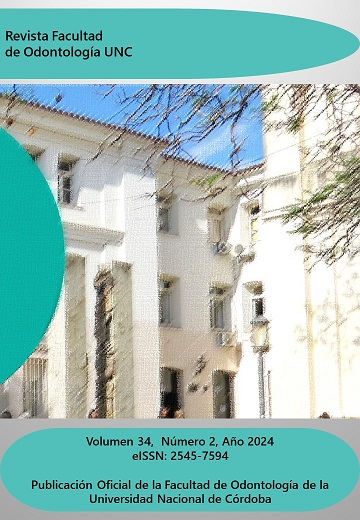Description of periapical lesions assessed with cone beam computed tomography
Keywords:
ConeBeam, Periapical lesions, Hipedense, HipodenseAbstract
Objective: To describe the prevalence of periapical lesions evaluated with cone beam computed tomography (CBCT). Materials and Methods: Observation through Planmeca's Romexis® viewer version 6 for Windows was used as a technique and a checklist was used as an instrument. 100 CBCT with periapical lesions were visualized detailing the variables hyperdense or hypodense, size and location. Results: It was indicated that 95% of the images found were hypodense and only 5% were hyperdense. In relation to the size of the lesions, the most prevalent were lesions in the range of 0 to 1.5 cm in diameter, followed by lesions of 1.6 to 3 cm in diameter. Larger lesions, exceeding 3.1cm, were only present in 2% of the CT scans. Among the areas most affected by periapical lesions were the upper maxillary area and the mandibular area. Conclusions: The hypodense lesions had a high prevalence, a high prevalence of the presence of bone cortex was noted in said lesions, the most prevalent lesions were lesions in the range of 0 to 1.5 cm in diameter. Among the areas most affected by periapical lesions, were the premolar area of the maxilla and the premolar and molar areas of the mandible
References
Furzan S, Jiménez L. Prevalencia de patologías periapicales en pacientes atendidos en el postgrado de endodoncia. Universidad de Carabobo. Período 2010-2013. Oral. 2016; 17(55):1391-1397.
2. Geibel MA, Schreiber ES, Bracher AK, Hell E, Ulrici J, Sailer LK, Ozpeynirci Y, Rasche V. Assessment of apical periodontitis by MRI: a feasibility study. Rofo. 2015 Apr;187(4):269-75. doi: 10.1055/s-0034-1385808. Epub 2015 Jan 16. PMID: 25594373.
3. Nicot RF, Fernández Y. Comportamiento de las patologías pulpares agudas. ASIC Santa Cruz del Este. Municipio Baruta. Caracas. Venezuela. Año 2007 – 2008.Publicado:30/08/2010. https://www.portalesmedicos.com/publicaciones/articles/2410/1/Comportamiento-de-las-patologias-pulpares-agudas-.html
4. Antony DP, Thomas T, Nivedhitha MS. Two-dimensional Periapical, Panoramic Radiography Versus Three-dimensional Cone-beam Computed Tomography in the Detection of Periapical Lesion After Endodontic Treatment: A Systematic Review. Cureus. 2020 Apr 19;12(4):e7736. doi: 10.7759/cureus.7736. PMID: 32440383; PMCID: PMC7237056.
5. Decurcio DA, Bueno MR, Silva JA, Loureiro MAZ, Damião Sousa-Neto M, Estrela C. Digital Planning on Guided Endodontics Technology. Braz Dent J. 2021 Sep-Dec;32(5):23-33. doi: 10.1590/0103-6440202104740. PMID: 34877975.
6. Lo Giudice R, Nicita F, Puleio F, Alibrandi A, Cervino G, Lizio AS, Pantaleo G. Accuracy of Periapical Radiography and CBCT in Endodontic Evaluation. Int J Dent. 2018 Oct 16; 2018:2514243. doi: 10.1155/2018/2514243. PMID: 30410540; PMCID: PMC6206562.
7. Wolf TG, Castañeda-López F, Gleißner L, Schulze R, Kuchen R, Briseño-Marroquín B. Detectability of simulated apical lesions on mandibular premolars and molars between radiographic intraoral and cone-beam computed tomography images: an ex vivo study. Sci Rep. 2022 Aug 18;12(1):14032. doi: 10.1038/s41598-022-18289-3. PMID: 35982122; PMCID: PMC9388656.
8. Saidi A, Naaman A, Zogheib C. Accuracy of Cone-beam Computed Tomography and Periapical Radiography in Endodontically Treated Teeth Evaluation: A Five-Year Retrospective Study. J Int Oral Health. 2015 Mar;7(3):15-9. PMID: 25878472; PMCID: PMC4385719.
9. Ali AH, Mahdee AF, Fadhil NH, Shihab DM. Prevalence of periapical lesions in non-endodontically and endodontically treated teeth in an urban Iraqi adult subpopulation: A retrospective CBCT analysis. J ClinExp Dent. 2022 Nov 1; 14(11):e953-e958. doi: 10.4317/jced.59877. PMID: 36458038; PMCID: PMC9701340.
10. Karamifar K, Tondari A, Saghiri MA. Endodontic Periapical Lesion: An Overview on the Etiology, Diagnosis and Current Treatment Modalities. EurEndod J. 2020 Jul 14; 5(2):54-67. doi: 10.14744/eej.2020.42714. PMID: 32766513; PMCID: PMC7398993.
11. Alsaikhan LS, Algarni RA, Alzahrani MA, Gufran K, Alqahtani AM, Altammami M, Mansy I. A comparative analysis of periapical status by using cone beam computed tomography and periapical radiography. Eur Rev Med Pharmacol Sci. 2022 Dec; 26(23):8816-8822. doi: 10.26355/eurrev_202212_30553. PMID: 36524500.
12. Quaresma SA, Costa RPD, Batalha B, Quaresma MCRD, Lopes FC, Mazzi-Chaves JF, Ginjeira A, Sousa-Neto MD. Management of periapical lesion with persistent exsudate. Braz Dent J. 2022 Jan-Feb;33(1):112-118. doi: 10.1590/0103-6440202204818. PMID: 35262549; PMCID: PMC9645141.
13. Talpos-Niculescu RM, Popa M, Rusu LC, Pricop MO, Nica LM, Talpos-Niculescu S. Conservative Approach in the Management of Large Periapical Cyst-Like Lesions. A Report of Two Cases. Medicina (Kaunas). 2021 May 14; 57(5):497. doi: 10.3390/medicina57050497. PMID: 34068934; PMCID: PMC8156608.
Downloads
Published
Issue
Section
License

This work is licensed under a Creative Commons Attribution-NonCommercial-ShareAlike 4.0 International License.
Aquellos autores/as que tengan publicaciones con esta revista, aceptan los términos siguientes:
- Los autores/as conservarán sus derechos de autor y garantizarán a la revista el derecho de primera publicación de su obra, el cuál estará simultáneamente sujeto a la Licencia de reconocimiento de Creative Commons que permite a terceros:
- Compartir — copiar y redistribuir el material en cualquier medio o formato
- La licenciante no puede revocar estas libertades en tanto usted siga los términos de la licencia
- Los autores/as podrán adoptar otros acuerdos de licencia no exclusiva de distribución de la versión de la obra publicada (p. ej.: depositarla en un archivo telemático institucional o publicarla en un volumen monográfico) siempre que se indique la publicación inicial en esta revista.
- Se permite y recomienda a los autores/as difundir su obra a través de Internet (p. ej.: en archivos telemáticos institucionales o en su página web) después del su publicación en la revista, lo cual puede producir intercambios interesantes y aumentar las citas de la obra publicada. (Véase El efecto del acceso abierto).

